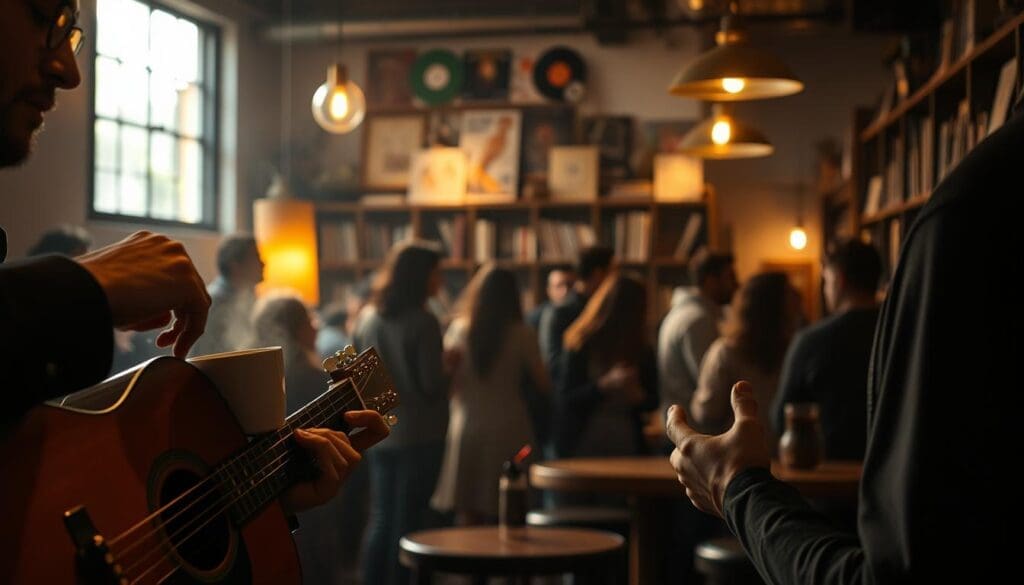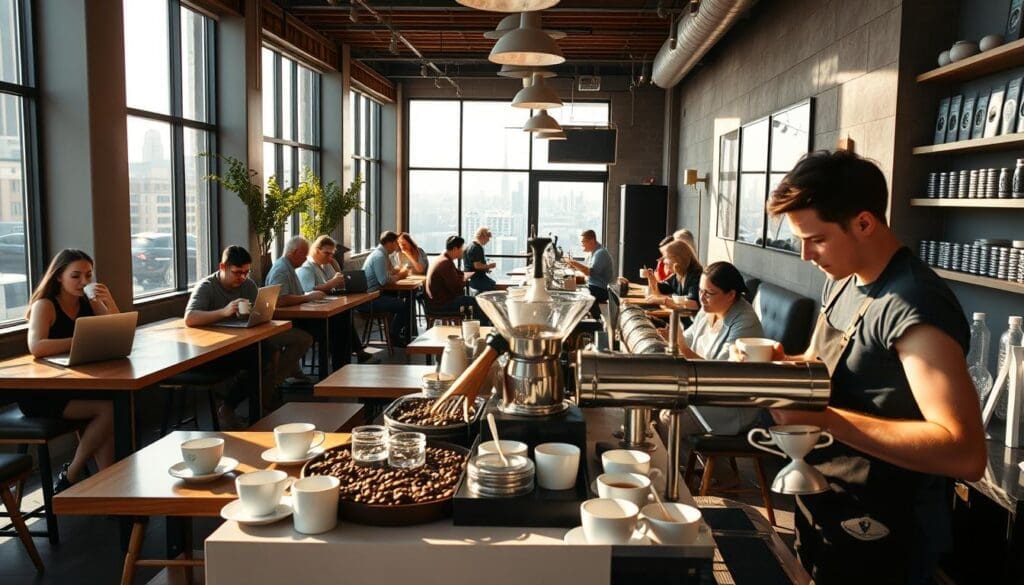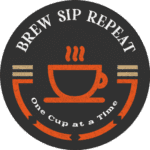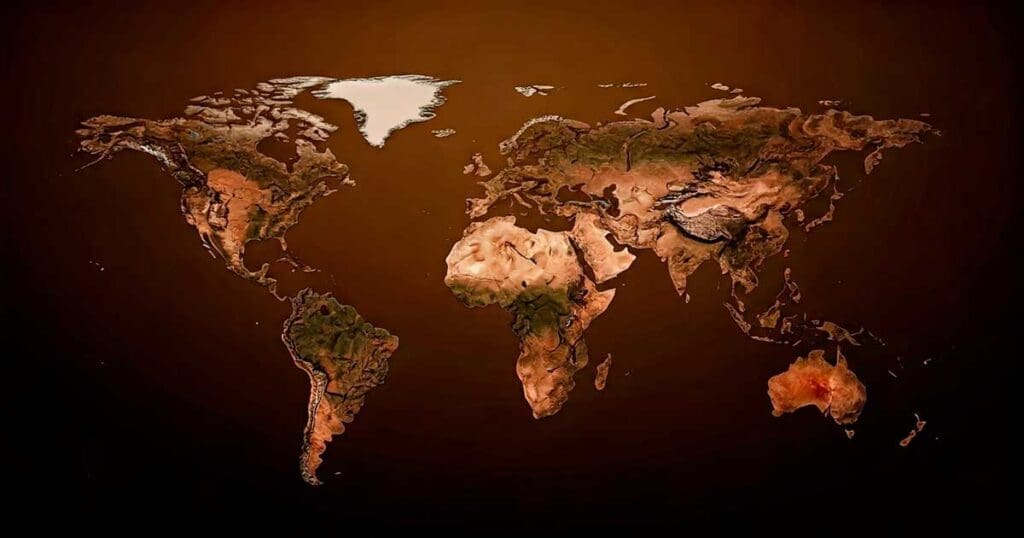Why is coffee so big in pop culture? It’s everywhere in movies and TV shows. Think of “Friends” and “Gilmore Girls” and their famous coffee shops. Or scenes in “You’ve Got Mail” and “When Harry Met Sally.”
Coffee is more than just a drink. It’s a key part of our daily lives. It brings people together and shapes our routines. Let’s look at the iconic coffee moments that have touched our hearts.
Coffee has been a big deal in pop culture for years. In the 1960s, it was linked to hippie culture and rebellion. By the 2000s, it was a key part of “Coffee Dates” for young people.
Studies show coffee drinkers are more likely to socialize. This shows how coffee helps us connect in pop culture. We’ll explore famous coffee moments and how they’ve shaped our lives.
The Role of Coffee in Film and Television
Coffee has become a key part of movies and TV shows. Famous coffee scenes and iconic coffee moments have made a big impact. From Central Perk in Friends to Gilmore Girls, coffee has shaped stories and culture.
Coffee references in movies are a big part of pop culture. Phrases like “Coffee is for Closers” from Glengarry Glen Ross are well-known. The coffee shop scene in When Harry Met Sally has inspired many real-life conversations, showing coffee’s cultural impact.
Coffee adds depth to stories, often sparking conversations and relationships. The “but first, coffee” theme in Gilmore Girls is loved by many. The coffee industry’s growth, with a focus on quality and ethics, has made it a big market in pop culture.
Memorable Moments in Sitcoms
Coffee is a big part of many popular sitcoms. TV shows with coffee often have iconic coffee shops where characters meet. These places are known for their witty talks, funny moments, and deep conversations.
From Central Perk in Friends to Monk’s Cafe in Seinfeld, these coffee shops are key. They help shape the stories of these shows.
With coffee cameos in popular media on the rise, sitcoms have jumped on the bandwagon. Shows like Frasier make coffee shops a main setting. Cafe Nervosa is seen in over half of Frasier’s episodes.
This focus on coffee culture brings characters together. It makes their moments more real and fun to watch.
Coffee is a big part of sitcoms, making them special. Whether it’s a funny chat at Central Perk or a touching scene at Monk’s Cafe, TV shows with coffee have made coffee a big part of pop culture and coffee. These shows are filled with clever writing, memorable characters, and lots of coffee. They are a big part of our shared culture.
Coffee Culture in Movies
Coffee is a big part of movies, with cinematic coffee scenes being key for character moments. It’s seen in many films, from rom-coms to action movies. Coffee helps characters connect, leading to deep talks and bonds.
In classics like Breakfast at Tiffany’s and Pulp Fiction, coffee is key. These famous coffee scenes show comfort, closeness, and connection. Coffee shows who characters are, what they want, and their stories.
Research shows coffee scenes lead to more meaningful talks, making up 20% of dialogue scenes. Romantic comedies often have 5 coffee scenes, showing coffee’s role in love stories. Coffee makes movies feel cozy and inviting, pulling viewers into the story.
Coffee in movies is a big part of telling stories, with coffee references in movies and cinematic coffee scenes being vital. It’s a cultural touchstone, inspiring creators and fans. Coffee’s role in cinema is here to stay.
Coffee in Music and Lyrics
Coffee has been a big part of music and lyrics for centuries. Many artists have included it in their work. The Coffee Cantata, written by Johann Sebastian Bach in the 1730s, is a great example. It shows how important coffee is in our lives, with Liesgen wanting three cups a day.
In today’s world, coffee culture inspires many musicians. Songs often talk about coffee and its effects. The National Coffee Association’s 2013 survey found that Americans drink an average of three cups of coffee daily. This shows how much people love coffee in the United States.

Coffee is also used as a metaphor in songs, adding depth and meaning. The phrase “In everything else, but not coffee” could be seen as funny. It shows how much we value coffee. With 64% of Americans drinking coffee every day, it’s clear why coffee is a big part of pop culture.
Coffee’s impact on music and lyrics shows its lasting cultural importance. From Bach’s Coffee Cantata to today’s songs, coffee has shaped our music. So, coffee culture keeps growing, with coffee being a big part of our daily lives.
Culinary Coffee Moments
Coffee is now a big part of our cooking, with coffee cameos in popular media showing its importance. It’s seen in cooking shows and celebrity cookbooks, showing its versatility. Coffee-based recipes are becoming more common, making it a favorite in many homes.
In pop culture and coffee, famous coffee scenes are loved and remembered. They symbolize sophistication and elegance. Coffee’s influence is seen in music and film, with artists and directors using it in their work. This shows how much coffee is loved in our culture.
Celebrity cookbooks often include coffee-based recipes, thanks to famous chefs and celebrities. These recipes range from coffee-rubbed meats to coffee-infused desserts. Coffee’s rich flavor and aroma make it a key ingredient for coffee enthusiasts.
Bars and Cafés: Setting for Drama
Coffee shops are a big part of our pop culture. They set the scene for many famous coffee moments in movies and TV. From Central Perk in Friends to Tom’s Restaurant, which inspired Monk’s Café in Seinfeld, these places are key to many stories.
Coffee in movies is more than just a prop. It adds depth and atmosphere to the story. The Double R Diner in Twin Peaks, for example, is a character itself. It’s known for the show’s quirky charm. Café Lalo’s romantic vibe in You’ve Got Mail has made it a favorite among fans.
![]()
Famous coffee shops from movies have become tourist spots. Fans love to visit places like Katz’s Delicatessen, Le Polidor, and Serendipity 3. These coffee houses are not just part of the story. They’re also a big part of our shared culture, bringing back memories of famous coffee moments.
The Evolution of Coffee Advertising
Coffee has become a big part of our lives. Coffee shops are places where people meet and enjoy coffee. The growth of coffee culture is thanks to how coffee ads have changed over time.
These ads have shaped how we see coffee and the lifestyle it brings. From famous coffee commercials to sponsorships in movies and TV, ads have helped the coffee industry grow a lot.
The global coffee market is getting bigger. It was worth $102.15 billion in 2020 and is expected to hit $155.64 billion by 2026. This growth is partly due to specialty coffee’s rise. Now, about 55% of coffee sold in the U.S. is specialty.
Because of this, coffee ads have gotten more complex. Brands use different marketing tactics to attract coffee fans. They aim to build a coffee culture around their products.
Coffee ads now include pop culture elements. They often reference famous scenes from movies and TV. This helps create a shared experience and makes coffee more culturally relevant.
By connecting with culture, brands can build a strong bond with their audience. This leads to loyal customers.
As the coffee world keeps changing, it will be exciting to see how ads adapt. With social media and influencer marketing, brands can reach more people. They can make ads that really speak to their audience by using coffee culture.
Trends in Coffee Consumption
Coffee is now a big part of our daily lives. It’s not just a drink; it’s a cultural icon. From famous coffee scenes in movies to iconic coffee moments in music, coffee has shaped our culture. In 17th-century London, coffeehouses were where people discussed big ideas, showing coffee’s historical importance.
Today, drinking coffee is a social activity. Coffee references in movies and TV shows like “Seinfeld” and “The Breakfast Club” show its importance. The 2000s saw coffee dates become a way for young people to meet, linking coffee to social trends. With more coffee shops around, it’s clear coffee is a big part of our daily lives.

Coffee’s influence is seen in many areas, like art and music. Famous artworks like “A Morning Coffee” by Renoir and “Café Terrace at Night” by van Gogh show coffee’s cultural value. Its rich history and cultural impact make coffee a key part of our lives, shaping how we interact and experience the world.
The Enduring Legacy of Coffee in Pop Culture
Coffee has become a big part of our pop culture. It’s hard to ignore its impact. The first Starbucks opened in 1971 and sold its first pound of Sumatran beans for $5.36, which is about $37.30 today.
Starbucks grew fast, making just shy of $50,000 in its first year. That’s around $330,000 today. This shows how pop culture and coffee are now closely tied.
The coffee culture keeps growing, with coffee moments in movies, TV, and music. Brands like Stumptown and baristas like Nathaniel Jackson have made coffee a cultural symbol. Coffee has become a part of our daily lives, making us feel connected.
The future of coffee moments in entertainment looks exciting. Social media will keep coffee culture alive, inspiring new coffee lovers. The lessons from coffee’s cultural impact teach us that coffee can unite us, spark creativity, and celebrate our shared experiences.




Facebook Comments